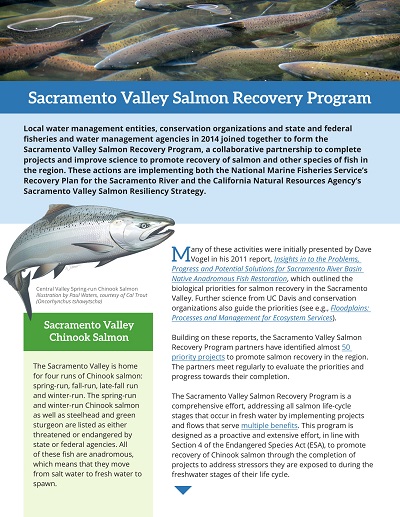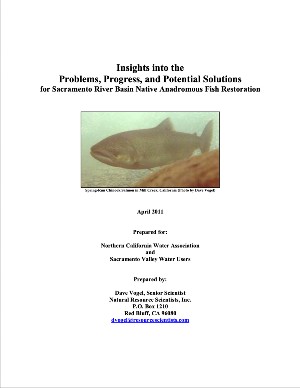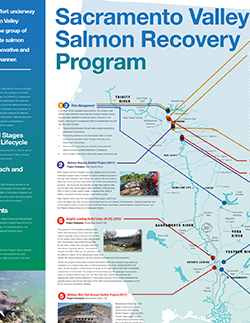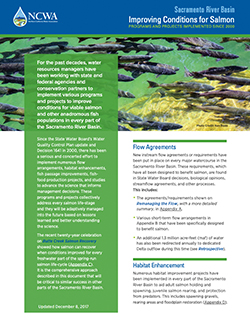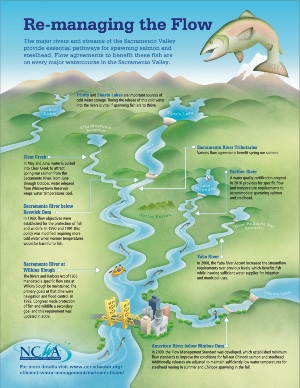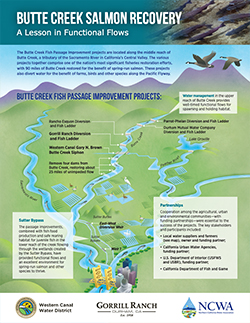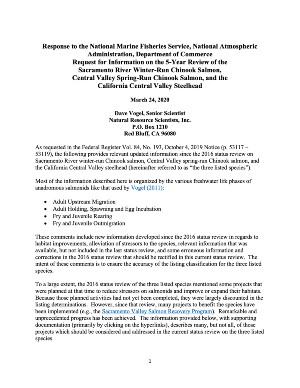The Sacramento Valley provides critical habitat for migrating and resident species of waterfowl, geese, shorebirds and waterbirds. This habitat comprises an important part of the integrated water system in Northern California. The Sacramento Valley lies on the southerly end of the Pacific Flyway migratory route and is one the most prominent wintering sites for waterfowl in the world. Waterfowl migrate to the Sacramento Valley by the millions from as far away as Alaska, Canada, and Siberia. Sacramento Valley habitat supports approximately 44 percent of wintering waterfowl using the Pacific Flyway, attracting more than 1.5 million ducks and 750,000 geese to its seasonal marshes. The limited amount of natural wetlands in the area makes small-grain production fields (mostly rice) critical to the survivability of the large numbers of waterfowl wintering in California. Many water districts and companies in addition to providing water for the working agricultural landscapes and privately managed wetlands also provide water to federal wildlife refuges and state wildlife management areas.
More than half of the Sacramento Valley’s wetlands are in private ownership, managed primarily for ducks and other waterfowl. The Sacramento Valley’s game refuges, rice fields, other wetlands, and agricultural properties provide exceptional habitat for wildlife, especially migratory waterfowl, shorebirds, waterbirds, and riparian songbirds. In total, these lands provide habitat for over 230 species of wildlife, including several listed species under the federal Endangered Species Act and the California Endangered Species Act.
Where fields are flooded, as is the case on wildlife refuges and winter flooded rice fields, large numbers of geese, ducks, swans, and other waterfowl, as well as wintering shorebirds, can be observed. Waterfowl arriving in the Central Valley during annual migrations require a diet rich in carbohydrates. Agricultural crops are preferred by the many species of waterfowl because they are widespread, easily accessible, and provide the needed high levels of carbohydrates. Waterfowl also benefit greatly from the invertebrate populations that thrive in flooded fields, especially during the molt and egg-laying periods, when all species of waterfowl have increased protein requirements. These areas also provide the necessary habitat and forage for wintering and breeding shorebirds and riparian songbirds.
The Sacramento Valley represents the single most important wintering area for the waterfowl along the Pacific Flyway. Migrating waterfowl rely upon this region of the state to rest and feed during their annual migration. In addition to the multiple species of waterfowl, raptors, and shorebirds that seasonally inhabit the region, these lands provide habitat for a number of other species who rely upon this area year-round. The refuges in the region provide year-round habitat that compliments the efforts of landowners that also provide habitat. The winter rice decomposition/waterfowl habitat program, along with the refuges, provides hundreds of thousands of acres every winter for migrating waterfowl and other species. This program allows wildlife enhancement to occur along with continued agricultural production. The habitat goals for the Pacific Flyway in the Central Valley are compiled in Central Valley Joint Venture Implementation Plan, which was published in 2006. These goals include water supply needs for the different basins located in the Central Valley, as well as conservation objectives for the six bird groups identified in the Plan (wintering waterfowl, breeding waterfowl, wintering shorebirds, breeding shorebirds, waterbirds, and riparian songbirds). These conservation objectives are also integrated in the plan to provide overall acreage and water supply objectives for seasonal wetland restoration, seasonal wetland enhancement, semi-permanent wetland restoration, riparian restoration, winter flooded rice, waterfowl-friendly agriculture, and agricultural easements (2006 Implementation Plan, pp. 239-252).
Central Valley Joint Venture
Central Valley Joint Venture 2006 Implementation Plan
California Rice Commission Wildlife

